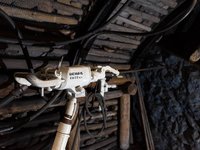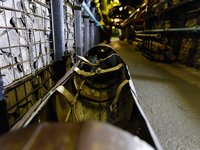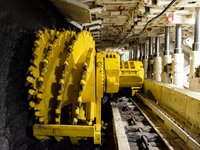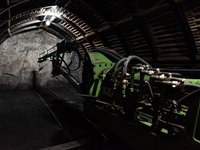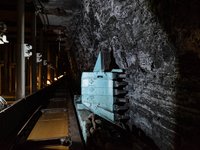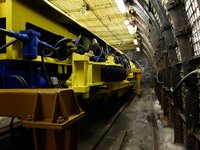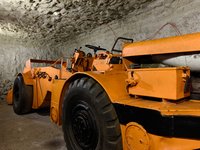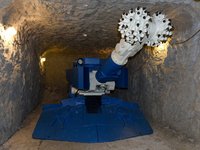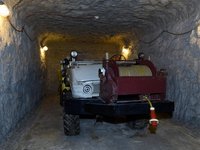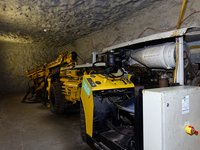Visitor's mine
Wasn’t the Deutsches Bergbau-Museum a mine at one time? No, it was not. But 20 metres down underground, we have constructed a visitor's mine based on an actual one. The entire tunnel network runs for approximately 2.5 km - 1.2 km of which is accessible to the public.
Alongside the imposing machinery on display here, visitors to the visitor's mine can also get a feel for the strenuous work routine experienced by miners. What were the working conditions like underground, and what technical developments transformed the daily working life here? Learn more by taking our Hard Coal Mine and Iron Ore Mine themed tours. A trip in the pit descent simulator is an essential element of every visit to the visitor's mine.
What did it actually look like underground in the past, how did people work and could they even understand their own words? Four new films offer exciting insights into the Leibniz Research Museum for Geo-resources. With the second one, we take you on an exciting journey into our visitor's mine.
You can find our video on YouTube here:
During the week, the visitor's mine is only open to visitors on guided tours, at weekends without a guided tour.
Access is via the elevator.
We recommend booking for the guided tours during the week by phone at +49 234 5877-220 (Tues. to Fri. between 9:00 am and 3:00 pm).
On weekends and for the "Triff den Bergmann" (Meet the Miner) format, visitors are regularly taken by elevator to the. It is not neccessary to register or reserve in advance.
The visit to the visitor's mine is possible for unaccompanied young people from the age of 12. Due to the special localities and the sometimes prevailing noise level, we recommend a visit for children accompanied from the age of 4.
Dress in warm clothes!
The average temperature in the visitor's mine is a relatively cool 12 °C. So it’s advisable to bring a warm pullover or jacket with you.
Our app
Please download the app before entering the visitor's mine. You cannot access your mobile data in the visitor's mine, the app only works there in offline mode. Once the app has been loaded onto your mobile device and opened once, it no longer requires an internet connection. For an undisturbed listening experience, the use of headphones is advisable.
Individual visitors
If you'd like to visit the Deutsches Bergbau-Museum on your own, you can do so without a guide during our opening times. Last admission to our visitor's mine is at 3:30 pm. Dates for the guided tours in the demonstration mine can be found in our calendar of events.
Groups
Groups of more than 10 are asked to contact us ahead of your visit – regardless of whether you want a guided tour or prefer to take the tour by yourself. This will help us to properly coordinate your visit and avoid unnecessary waiting times. You can contact us by email service@bergbaumuseum.de or by telephone: +49 234 5877-220 (Tues. to Fri. between 9:00 am and 3:00 pm).
Feel free to use our registration form.
Information for schools
The charge for guided tours through our visitor's mine is 40 € per class plus admission fee for each participant. 2 accompanying persons per 20 pupils will have free admission. Guided tours for schools are available in English and French at request, depending on availabilty. The charge for these guided tours is 60 € per class admission fee for each participant.
Registration for guided tours and mediation services is required. We have created a form for this purpose, with which you can already prepare your visit online.
Free admission for Bochum schools
Thanks to generous funding from the RAG Foundation, class groups from Bochum schools with a social index level of 3 or higher receive free admission and a free guided tour of the Deutsches Bergbau-Museum Bochum. Registration via our contact form is required. You can find more information here and in our flyer.
Themed tour: coal mine
Most of the visitor mine is devoted to coal mining. The actual mining activities include the creation of mine structures and the extraction of coal: an underwater tableau shows how the blind shaft, which had become flooded since its construction, was manually deepened in the 1960s. Two kinds of tunnel driving are shown: excavation with a full-face boring machine and with drilling and blasting. Coal extraction can be found at two workings with a chain coal cutter and with pneumatic picks, and in three longwall workings or faces. The first of these shows the use of a coal plough to shear off slabs of coal, combined with individual props for roof support (1950s/1960s), the second shows a shearer loader being used to cut coal, in combination with self-advancing supports (1960s/1970s). The third face fills in the technological gap between then and the present with equipment such as the double-drum shearer loader and powered roof supports. These are typical of the German coal-mining industry today, where the average length of the longwall faces is 300 to 400 m. The coal-mine themed tour also shows numerous items of equipment with logistic and safety-related functions.
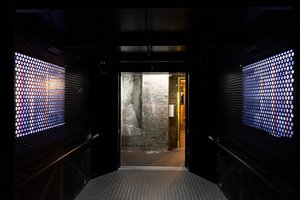
In this part of the world it was usual for underground mines to opened up through vertical shafts that descended from the surface. Workers and materials are transported in a “cage", a robust kind of lift car suspended within the shaft by a cable and moved upwards and downwards by a hoist. The inward and outward journey of the miners in the cage was known as “men hoisting”. The pit descent is a thoroughly exciting experience because of how the cage travels at high speed through the dark shaft, with intermittent shakes making it quite noisy at times, all the while with very little protection from the air blast.
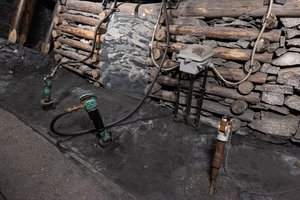
In the coal-mining industry, the pick or pickaxe, which had long been the main tool of extraction, was replaced in the 1920s by the pneumatic pick. From the mid-1950s the pneumatic pick was increasingly superseded by the coal plough and the shearer loader.
Today the pneumatic pick is only used for ancillary work.
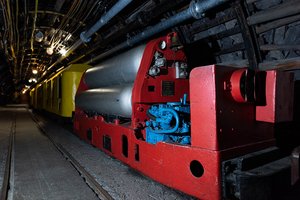
In the complex tunnel network of an underground coal mine, many transport operations are carried out on railway tracks.
Today the locomotives are usually equipped with a diesel motor or an electric engine. In the past there were also benzene locomotives and compressed-air locomotives.
In the tunnel network of the visitor mine, which is around 2.5 km long, small electric locomotives are used for transport. One or two of these locomotives are usually to be found in the battery charging room, very close to the shaft.
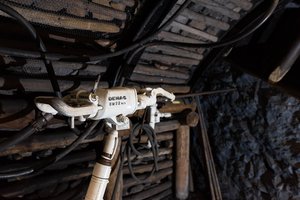
The pneumatic hammer drill, in use since the beginning of the 20th century, constitutes a major advance in the making of blast boreholes, which used to be laboriously drilled by hand. The drill column, which is also pneumatically driven, bears the weight of the hammer drill and generates the pressure needed for drilling. To reduce the risk of black lung disease, the drilling dust is extracted by suction or suppressed using water. These days hammer drills are used in situations where the use of a drilling jumbo is not possible or expedient.
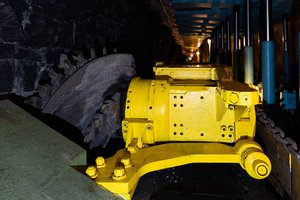
On this face, the coal is cut out of the seam by a shearer loader. It represents the state of technology from the mid-1960s to the mid-1970s.
The single-drum shearer cuts the coal out of the seam as it moves in one direction, and loads it onto the scraper chain conveyor with its rake blade on its return.
The hydraulic self-advancing supports, here in the form of support props, prevent the rock from falling down. Behind the props, the rock is allowed to collapse.
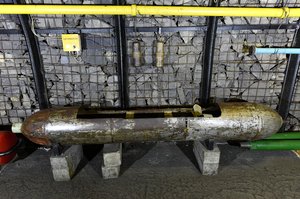
The first “Dahlbusch bomb” was built at the Dahlbusch mine in Gelsenkirchen in 1955. Here it was used to free three trapped miners, who could only be rescued through a drill hole. The most famous use of a Dahlbusch bomb, known as the “Miracle of Lengede”, took place in 1963. In this mining accident, ten miners who had been trapped for two weeks were rescued with the help of the “bomb” – miraculously unharmed.
A similar rescue device was used to free 33 miners in Chile in 2010.
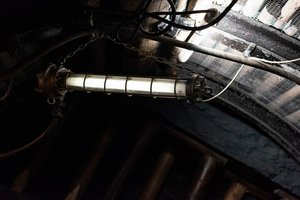
In coal mines the lighting has to be constructed in such a way that explosive mixtures of air and firedamp (methane) cannot be ignited.
The compressed air lamp is particularly safe in this respect. It only works if its protective glass cylinder is intact and airtight. If this is the case the compressed air drives a small turbine generator, thus producing electrical energy. If the glass cylinder is damaged, the compressed air escapes and no electricity is generated.
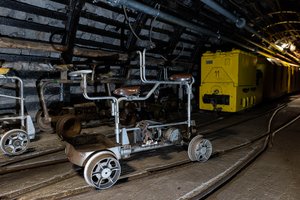
Mine bicycles are often used by tradesmen, who have to be able to get to their workplace at any time. Blasters, who are not allowed to use the passenger train with their explosives, also make use of bicycles. The mine bicycles are usually equipped with a second seat. The seat without pedals is most popular.
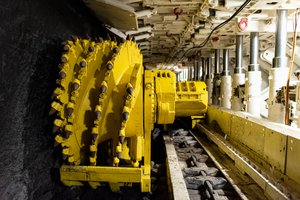
The visitor mine took several years to construct. In this period, the museum’s miners removed 2500 m3 of rock, transported it to the surface, and excavated 100 m of new tunnels. Finally, around 27 powered roof supports, roughly 50 m of scraper chain conveyors, a double-drum shearer loader (cutting machine) and a continuous miner (tunnelling machine) were installed.
The result was a state-of-the-art longwall face, of the type generally to be found in the Ruhr today. Visitors can now see and experience a high-tech longwall face, the culmination of years of mining technology development.
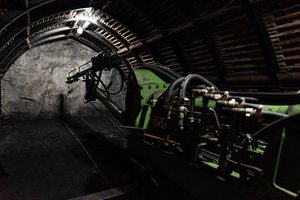
The blasting section in the visitor mine shows the state of mining technology at the end of the 1950s. The main equipment used for this is the pneumatic drilling jumbo. The rotary percussive drill can be moved by means of the boom.
Working with this drilling jumbo is less physically strenuous, as it only involves control levers. The noise exposure is high, however.
The following tasks are repeated constantly: drilling of blasting holes, blasting, removing the debris, and supporting (securing) the newly created cavity.
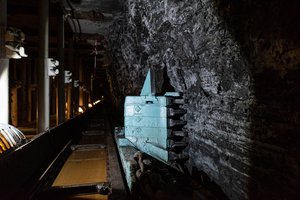
The visitor mine’s 80 m long plough face, in a shallow, 2 m thick coal seam, reflects the state of technology for roof support, extraction and backfilling in the 1950s and 1960s.
Individual props support the roof (the rock above the coal). A coal plough slabs off the coal from the seam and loads it onto a scraper chain conveyor. The cavity behind the face is filled mechanically with rock (pneumatic stowing). The filling material reaches the pneumatic stowing machine through a central pipeline.
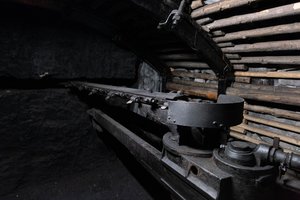
The chain coal cutter was powered by a pneumatic motor and had a chain fitted with picks – similar to a chainsaw – with which it was able to cut a groove a few centimetres wide into the coal face.
For greater stability, the machine was clamped between the roof and the floor of the tunnel. The groove made it easier to loosen the remaining coal with the pneumatic pick.
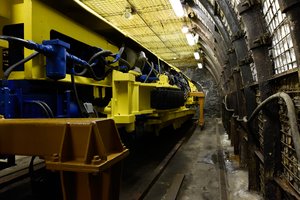
Tunnelling machines are one way to create galleries in a mine.
“Full-face boring machines” are particularly effective; like the tunnel boring machine in the visitor mine, these cut a circular tunnel cross-section into the rock.
Extensive preparations are needed before such machines can be used. For example, they have to be assembled underground from individual components. This kind of tunnelling technology is therefore only worthwhile when particularly long galleries need to be excavated.
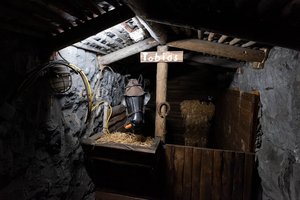
The mine horses were used for the transport of coal, rock and other materials. They usually remained underground for several years, and some eventually went blind. It is said that the mine horses were able to count: if more mine cars than usual were attached, the horses simply refused to move.
The last mine horse in the coal mines of the Ruhr district was called Tobias. He remained in service underground at the General Blumenthal mine in Recklinghausen until 1966.
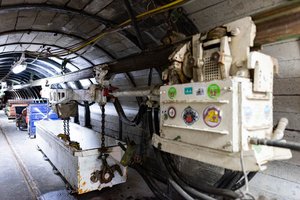
The overhead monorail is a typical mode of transport in coal mining. It is mainly used near the working face, where no normal trains can travel.
The track of the overhead monorail is suspended from chains, so this system of transport is independent of the condition of the floor.
For shorter distances the main mode of transport used is pneumatically powered overhead railways (shunting trolleys). For longer distances, on the other hand, rope-hauled or self-propelling rail systems are more suitable, usually in the form of diesel trolleys.
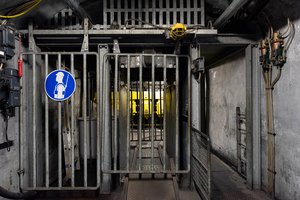
The floors (the different levels of a mine) are connected to each other by sloping galleries or vertical shafts. A shaft which only connects two or more floors of a mine is called a blind shaft, because it doesn’t see the light of day.
In the recreated blind shaft in the visitor mine, the shaft gates can be opened and the swinging platform can be activated. When the platform has descended, wagons carrying materials can be pushed onto the pit cage, or people can enter the cage.
Themed tour: iron ore mine
The iron ore mining section shows how iron ore was extracted in northern Germany until the end of the 1970s, using the room and pillar system.
Between the rooms, part of the surrounding rock remains standing as a support. One room shows how the ore is extracted by cutting, using a continuous miner. Three further rooms show extraction by drilling and blasting. Here self-propelling equipment is used: the drilling jumbo, the explosives truck and the loader use diesel motors to drive from one room to the next. In another room visitors can see a “part-face heading machine”, which cuts out the rock with its movable cutter head.
